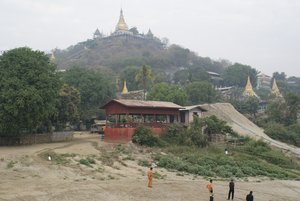Advertisement
Published: March 14th 2016

 Sagaing
Sagaing
Sagaing as we are pulling in.Day 10-Friday-January 22 This morning we are in Sagaing, the capital of the Sagaing region, famous for over 200 monasteries and its tranquil atmosphere. It is an important religious and monastic center. The pagodas and monasteries crowd the numerous hills along the ridge running parallel to the river. On August 8, 1988, Sagaing was the site of demonstrations which were concluded by a massacre in which around 300 civilians were killed. The central pagoda, Soon U Ponya Shin Pagoda, is connected by a set of covered staircases that run up the 800 foot hill. The Shan chieftain, AthinkhayaSwayun, founded Sagaing in 1315, but the capital was relocated again 50 years later by Thadominbya. It was once again a capital city from 1760-1764. There are no vestiges of the former palace-city but the vicinity abounds with ornate pagodas. All of Sagaing’s main sites can be seen from the top of Sagaing Hill. It is a serene and peaceful location and the ideal setting for Buddhist studies and meditation. This morning we started as a complete group and went to the Zayar Theingi Nunnery and met the nuns. We had the opportunity to line up on each side of a runner and offer

 Into port
Into port
A small village along the river.bags of rice to the nuns as alms. After that we were able to ask questions of several of the senior nuns about their lives as nuns, the nunnery and their daily routines. Duli interpreted the Q & A and showed us their chart of daily activities. The nun who acted as the spokesperson was 77 years old and had been there since she was eleven. We concluded our visit with a prayer from the nuns wishing us well.
We then got back on the buses and made our way up to Sagaing Hill where we visited the Soon U Ponya Shin Pagoda which houses a very large Buddha and offered beautiful surrounding views of other pagodas and the river. It is one of the oldest temples on Sagaing Hill, built in 1312. We then went to U min Thonze Pagoda, also situated atop Sagaing Hill. U min Thonze means 30 Caves. It was built by a venerable monk named Padugyi Thangayaza. The caves are entry ways into the area where there are 45 Buddha images that sit in a crescent-shaped colonnade within the pagoda. The entrances and the archways are decorated with fine stucco work with the figures

 Good morning!
Good morning!
A nun near the nunnery.of spirits and mythological beings.
We returned to the boat for lunch after which we departed for the short ride to Inwa, the capital of the Burmese kingdom between the decline of Bagan around 1300 and the final move to Amarapura around 1837. The village is located at the confluence of the Ayeyarwady River and Myintge River. We arrived about 2:00 and were treated to a horse-drawn cart ride through the paddy fields to our destination of the Bargaya Monastery, a splendid teak wood structure built in 1834 and intricately designed with wood carvings. We were able to see some youngsters in a classroom studying. We returned to our carts and back to the boat. We departed Inwa about 3:30 for our next destination, Yandabo.
We then enjoyed an ice cream social on the sundeck followed by a presentation given by Duli on the Myanmar culture.
The Ayeyarwady River is a life-sustaining waterway celebrated in legend, song and literature. Rudyard Kipling’s well-known poem, “The Road to Mandalay,” refers not to a road at all but to this very river, which sweeps from the snow-capped Himalayas in the far north down the full length of the country until
it empties into the Andaman Sea. The Ayeyarwady played a key role during the rule of every Burmese king, and all of the country’s royal capitals were once set along its banks. Thousands of temples, stupas and pagodas can still be seen along its great length, as well as exotic scenes that have endured for centuries – smiling women in bright sarongs, dark-robed monks gathering alms, rice farmers leading ox carts along the river. The essence of ancient Burma lingers on. The 1,350-mile long Ayeyarwady has an illustrious history. In the mid-19th century British colonial era, the river was one of the world’s most popular waterways, and the Irrawaddy Flotilla Company’s shallow draft paddle steamers greatly contributed to Myanmar’s transformation into the “Rice Bowl of Asia.” Years later when the Japanese invaded Burma during WWII, the company scuttled its entire 600-ship fleet to prevent the Axis forces from seizing it. In 1948, Burma gained its independence from Britain, changed its name, closed its borders and essentially slipped off the radar of the outside world. Today, after more than half a century of self-imposed political isolation, Myanmar has re-emerged and welcomes visitors with open arms.
Advertisement
Tot: 0.077s; Tpl: 0.016s; cc: 11; qc: 28; dbt: 0.0454s; 1; m:domysql w:travelblog (10.17.0.13); sld: 1;
; mem: 1.1mb
























